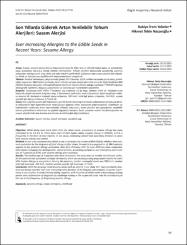| dc.contributor.author | Yekeler, Rukiye İrem | |
| dc.contributor.author | Nacaroğlu, Hikmet Tekin | |
| dc.date.accessioned | 2020-08-14T07:02:55Z | |
| dc.date.available | 2020-08-14T07:02:55Z | |
| dc.date.issued | 2020 | en_US |
| dc.identifier.citation | Yekeler, R. İ. ve Nacaroğlu, H. T. (2020). Son yıllarda giderek artan yenilebilir tohum alerjileri: Susam alerjisi. İzmir Dr. Behçet Uz Çocuk Hastanesi Dergisi, 10(1), 77-81. https://dx.doi.org/10.5222/buchd.2020.87513 | en_US |
| dc.identifier.issn | 2146-2372 | |
| dc.identifier.issn | 1309-9566 | |
| dc.identifier.uri | https://dx.doi.org/10.5222/buchd.2020.87513 | |
| dc.identifier.uri | https://hdl.handle.net/20.500.12511/5734 | |
| dc.description.abstract | Amaç: Susam, önemli alerjenitesi ve hipersensitivitesi ile diğer tohum allerjilerinden daha sık görülmekteolup; prevalansı %0,1-0,2 olarak tahmin edilmektedir. Tohum alerjileri konusunda çocuklarda yapılmışçalışmalar oldukça sınırlı olup daha çok vaka takdimi şeklindedir. Çalışmamızda susam alerjisi olan olguların klinik ve laboratuvar özelliklerinin değerlendirilmesi amaçlandı.Yöntem: Kesitsel tanımlayıcı çalışmamızda Şubat 2017-Haziran 2019 tarihleri arasında çocuk alerji polikliniğine başvuran 3863 hasta içerisinde, besin alerijsi ve/veya atopik dermatit tanısı ile değerlendirilen 804(%20,8) hastanın dosyaları retrospektif olarak incelendi. Susam alerjisi olduğu saptanan 7 (%0,87) olgunundemografik özellikleri, başvuru yakınmaları ve laboratuvar incelemeleri kaydedildi.Bulgular: Çalışmaya dahil edilen 7 hastanın yaş ortancası 11 ay olup, tamamı erkek idi. Hastalarımızınhepsinde atopik dermatit bulguları olup, 1 hastamızda eşlik eden inek sütü proteini ilişkili anafilaksi tablosu mevcut idi. Hastaların eozinofil sayısı ortancası; 780 mm3, total IgE düzeyi ortancası; 264 IU/L, susamspesifik IgE düzeyi ortancası 2,7 kU/L idi.Sonuç: Son yıllarda susam gibi tohumların günlük beslenme programımızda kullanımının artmasıyla birlikte tohumlarla ilgili hipersensitivite reaksiyonları giderek artan oranlarda bildirilmektedir. Ülkemizde sıktüketilmeleri nedeniyle önem taşımaktadır. Dikkatli öykü alımı, besin alerjileri test panellerine yenilebilirtohum-çekirdeklerin eklenmesi ve şüpheli olgularda tanıların besin yükleme testleri konfirmasyonları ilesusam alerjilerinde tanı konma oranlarının artabileceğini düşünmekteyiz. | en_US |
| dc.description.abstract | Objective: While being seen more often than the other seeds, prevalence of sesame allergy has been estimated to be 0.1-0.2 %. There have been limited studies about sesame allergy in children, and it is frequently in the form of case reports. In our study, evaluating clinical and laboratory features in cases with sesame allergy was aimed.Method: In our cross sectional-descriptive study, a retrospective review of 804 (%20.8) children who received evaluation by the diagnosis of food allergy and/or atopic dermatitis in a population of 3863 patients applied to the pediatric allergy outpatient clinic from February 2017 to June 2019 has been conducted. Information including the demographic characteristics, presenting symptoms and laboratory examinations of 7 patients (0.87%) with sesame allergy were recorded.Results: The median age of 7 patients who were included in the study was 11 months and all were males. All the patients had symptoms of atopic dermatitis, there was accompanying anaphylaxis related to Cow's Milk Protein Allergy in one patient. Among the patients; median eosinophil count was:780/mm(3), median total IgE level was: 264 IU/L, median sesame specific IgE level was: 2.7 IU/L.Conclusion: With the growing trend of using seeds such as sesame in our daily diet, hypersensitivity reactions are being reported with ever increasing rates Because of its frequent consumption, it carries importance in our country. A careful history taking, together with inclusion of edible seeds in food allergy testing panels and confirmation of diagnosis by challenge testing in the suspected cases may be contributing to the rise in the frequency of diagnosing sesame allergy. | en_US |
| dc.language.iso | tur | en_US |
| dc.publisher | Dr. Behçet Uz Çocuk Hastalıkları ve Cerrahisi | en_US |
| dc.rights | info:eu-repo/semantics/openAccess | en_US |
| dc.rights | Attribution-NonCommercial 4.0 International | * |
| dc.rights.uri | https://creativecommons.org/licenses/by-nc/4.0/ | * |
| dc.subject | Susam Alerjisi | en_US |
| dc.subject | Atopik Dermatit | en_US |
| dc.subject | Çocukluk Çağı | en_US |
| dc.subject | Sesame Allergy | en_US |
| dc.subject | Atopic Dermatitis | en_US |
| dc.subject | Childhood | en_US |
| dc.title | Son yıllarda giderek artan yenilebilir tohum alerjileri: Susam alerjisi | en_US |
| dc.title.alternative | Ever increasing allergies to the edible seeds in recent years: Sesame allergy | en_US |
| dc.type | article | en_US |
| dc.relation.ispartof | İzmir Dr. Behçet Uz Çocuk Hastanesi Dergisi | en_US |
| dc.department | İstanbul Medipol Üniversitesi, Tıp Fakültesi, Dahili Tıp Bilimleri Bölümü, Çocuk Sağlığı ve Hastalıkları Ana Bilim Dalı | en_US |
| dc.authorid | 0000-0002-2391-5807 | en_US |
| dc.authorid | 0000-0003-1333-2648 | en_US |
| dc.identifier.volume | 10 | en_US |
| dc.identifier.issue | 1 | en_US |
| dc.identifier.startpage | 77 | en_US |
| dc.identifier.endpage | 81 | en_US |
| dc.relation.publicationcategory | Makale - Uluslararası Hakemli Dergi - Kurum Öğretim Elemanı | en_US |
| dc.identifier.doi | 10.5222/buchd.2020.87513 | en_US |




















